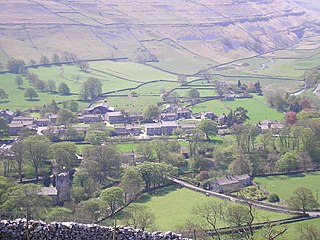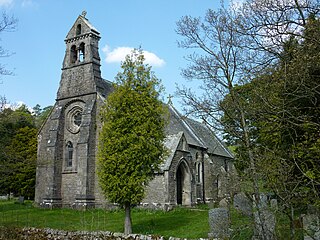
Wensleydale is a valley in North Yorkshire, England. It is one of the Yorkshire Dales, which are part of the Pennines. The dale is named after the village of Wensley, formerly the valley's market town. The principal river of the valley is the Ure, which is the source of the alternative name Yoredale. The majority of the dale is within the Yorkshire Dales National Park; the part below East Witton is within the national landscape of Nidderdale.

Arncliffe is a small village and civil parish in Littondale, one of the Yorkshire Dales in England. Littondale is a small valley beside Upper Wharfedale, 3 miles (4.8 km) beyond Kilnsey and its famous crag. It is part of the Craven district of the non-metropolitan county of North Yorkshire, but is in the historic West Riding of Yorkshire. The population of the civil parish was estimated at 80 in 2015.

Seacroft is an outer-city suburb/township consisting mainly of council estate housing covering an extensive area of east Leeds, West Yorkshire, England. It lies in the LS14 Leeds postcode area, around 4 miles (6.4 km) east of Leeds city centre.

Grassington is a village and civil parish in North Yorkshire, England. The population of the parish at the 2011 Census was 1,126. Historically part of the West Riding of Yorkshire, and now in the lieutenancy area of North Yorkshire, the village is situated in Wharfedale, about 8 miles (10 km) north-west from Bolton Abbey, and is surrounded by limestone scenery. Nearby villages include Linton, Threshfield, Hebden, Conistone and Kilnsey.

Muker is a village and civil parish at the western end of Swaledale in North Yorkshire, England, within the Yorkshire Dales.

Askrigg is a small village and civil parish in Wensleydale in the Yorkshire Dales National Park. It was formerly a part of the Richmondshire district of North Yorkshire, England. The village and its parish are located in Upper Wensleydale, 12 miles (19 km) west of Leyburn, and 5 miles (8 km) east of Hawes. It is 31.4 miles (50.5 km) west of the county town of Northallerton.

Aysgarth is a village and civil parish in Wensleydale, in North Yorkshire, England. The village is in the Yorkshire Dales National Park, about 16 miles (26 km) south-west of Richmond and 22.6 miles (36.4 km) west of the county town of Northallerton.

The Tan Hill Inn is a public house at Tan Hill, North Yorkshire. It is the highest inn in the British Isles at 1,732 feet (528 m) above sea level. According to the Guinness Book of World Records, it is slightly higher than the Cat and Fiddle Inn in the Peak District, which is at 1,690 feet (520 m).

Darrowby is a fictional village in the North Riding of Yorkshire, England, which was created by author Alf Wight under the pen name of James Herriot as the setting for the veterinary practice in his book It Shouldn't Happen to a Vet. The book has been adapted for two television series, both titled All Creatures Great and Small. The first was the BBC's 1978 series, which aired between 1978 and 1990. A new adaptation was produced for the 2020 series.

Redmire is a village and civil parish in North Yorkshire, England. It is about 4 miles (6.4 km) west of Leyburn in Wensleydale in the Yorkshire Dales.

Worton is a hamlet in Wensleydale in the Yorkshire Dales in the Richmondshire district of North Yorkshire, England. It lies 1-mile (1.6 km) east of Bainbridge on the A684 road, 4 miles (6.4 km) west of Aysgarth and 1-mile (1.6 km) south east of Askrigg. The hamlet is just south of the River Ure, the biggest river in Wensleydale. The hamlet is named in the Domesday Book and its name derives from the Old English wyrt-tūn and means the garden.

Hardraw is a hamlet near Hawes within the Yorkshire Dales in North Yorkshire, England. It takes its name from the nearby Hardraw Force waterfall.

Constable Burton Hall is a Grade I-listed Georgian country house of dressed stone in an extensive and well wooded park in the village of Constable Burton in North Yorkshire, designed by John Carr of York in 1768. It is privately owned by the Wyvill family. The house is a two-storey ashlar-faced structure with a five bay frontage having an elegant recessed Ionic portico. The principal entrance is approached by a double flight of steps. The side elevation has a pediment and there is a large projecting bay to the rear of the house.

All Creatures Great and Small is a British television series made by the BBC and based on the books of the British veterinary surgeon Alf Wight, who wrote under the pseudonym James Herriot. Set in the Yorkshire Dales and beginning in the mid-1930s, it stars Christopher Timothy as Herriot, Robert Hardy as Siegfried Farnon, the proprietor of the Skeldale House surgery, and Peter Davison as Siegfried's "little brother", Tristan. Herriot's wife, Helen, was initially played by Carol Drinkwater and in the later series by Lynda Bellingham.

St Mary and St John's Church, Hardraw is a Grade II listed parish church in the Church of England in Hardraw, North Yorkshire.
The All Creatures Great and Small franchise consists of a series of books, movies, and TV series based on books written by James Alfred Wight under the pen name James Herriot based on his experiences as a veterinary surgeon. The books have been adapted for film and television, including a 1975 film All Creatures Great and Small, followed by the 1976 It Shouldn't Happen to a Vet sequel, as well as a long-running BBC television programme of the same title, and a prequel series in 2011, Young James Herriot.

The Golden Beam is a pub and Grade II listed building located in the Headingley area of Leeds, West Yorkshire, England. It was built in c. 1912 for the Church of Christ, Scientist, and was known as the Elinor Lupton Centre from 1986 to 2010 when it was a school arts centre. It was designed by Piet de Jong and William Peel Schofield from the architectural firm Schofield and Berry. Constructed in white Portland stone in a mixed style of Egyptian Revival and Art Deco, it was originally built as a Sunday school in c. 1912–1914, extended in the 1930s with a church building and then used by the Leeds Girls' High School as a theatre and music centre from 1986 until 2010. The structure has architectural significance in the locality due to its distinct style and use of materials; many original features and fittings survive, including the entrance foyer, two staircases and a glazed lantern in the auditorium roof.

All Creatures Great and Small is a television series set in 1930s Northern England, based upon a series of books about a Yorkshire veterinary surgeon written by Alf Wight under the pen name of James Herriot. The series, produced by Playground Entertainment for Channel 5, is a new adaptation of Wight's books, following the previous BBC series of 90 episodes that ran from 1978 to 1990 and a number of other films and television series based on Herriot's novels. It was filmed in the Yorkshire Dales, and received funding from Screen Yorkshire.

Cringley House is an historic building in the English village of Askrigg, North Yorkshire. Standing on the south side of Market Place, it was built in the early-to-mid-19th century, and is now a Grade II listed building. Its railings are also of listed status.
Askrigg is a civil parish in the former Richmondshire district of North Yorkshire, England. It contains 38 listed buildings that are recorded in the National Heritage List for England. Of these, two are listed at Grade I, the highest of the three grades, one is at Grade II*, the middle grade, and the others are at Grade II, the lowest grade. The parish contains the village of Askrigg, the hamlet of Woodhall, and the surrounding countryside. Most of the listed buildings are houses, cottages and associated structures. The others include a church, shops, farmhouses and farm buildings, a hotel, former mills, a market cross, a village pump and a telephone kiosk.



















